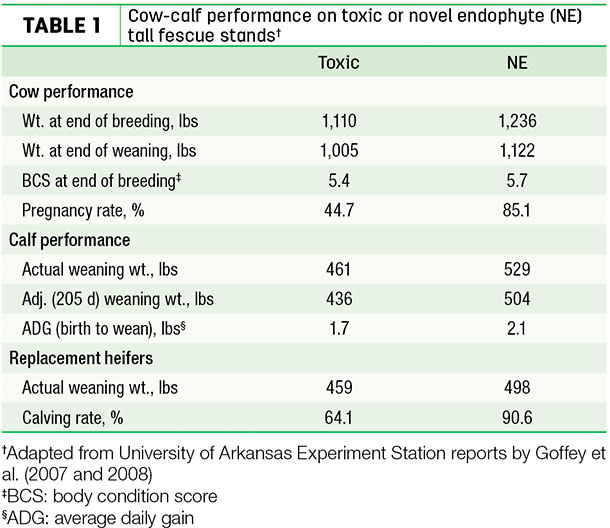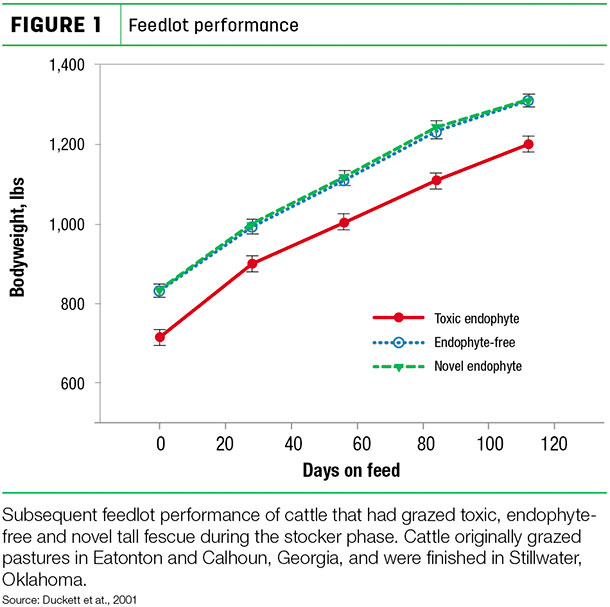Assuming you make a full recovery, you will have a clearer understanding of why livestock grazing on toxic endophyte-infected tall fescue have such a hard time.
Hidden curse in the ‘wonder grass’
One fateful day in 1931, E.N. Fergus from the University of Kentucky visited a farm outside tiny Frenchburg, Kentucky, to see the “wonder grass” that grew on William O. Suiter’s hillside pastures. Fergus was impressed by how this grass held the hilly terrain and stayed green late into the winter. He had no idea the plant had a fungus that lived inside it producing toxic alkaloids. Soon after Kentucky-31 was released in 1943, reports of poor cattle performance began to be reported.
As early as 1948, researchers in New Zealand declared “tall fescue is poison for cattle,” and similar conclusions were drawn by Ohioans in 1950. The complete list of symptoms are too long to include, but the most problematic are high body temperature, failure to shed the winter hair coat, reduced feed intake, poor weight gain, difficulties in giving birth and low pregnancy rates. Combined, the effects of these toxins are estimated to cost U.S. beef producers over $1 billion annually.
The toxic alkaloids produced by the fungus, of which there are many, severely disrupt the animal’s endocrine system and cause blood vessel constrictions that reduce blood flow to the extremities. The latter is what causes the animal to suffer more from the heat of a summer’s day.
Normal body temperature in a cow runs from about 100.5ºF to 102.5ºF. On a hot day, it might touch 103ºF. Researchers at the USDA Forage-Animal Production Research Unit in Kentucky measured the body temperature of cattle grazing toxic tall fescue and found the body temperature was a full 1.5ºF higher than a similar group of cattle grazing nontoxic tall fescue. This may sound slight, but if you have ever had a cold or low-grade fever in the summer months, you should be sympathetic.
The effects tend to linger longer than a spring break hangover. Once the cattle in that Kentucky study were moved to nontoxic pastures, it took up to three-and-a-half weeks for body temperatures to return to normal. Such cattle do not sweat as much and are wholly unable to regulate their body temperatures. Stressful conditions on these cattle, especially when they are worked through pens and cattle-handling facilities or driven too quickly from one place to another, often make matters much worse.
In the end, animal performance suffers substantially. For example, cow-calf herds grazing toxic tall fescue often produce 30 percent fewer calves, and those calves may be 50 to 80 pounds lighter than cattle grazing the nontoxic, novel endophyte tall fescues (Table 1).

These cattle seem to always lag behind, even after they make it to the feedlot.
In a study nearly 20 years ago, calves that had been backgrounded on toxic tall fescue in Georgia ended up approximately 100 pounds lighter than similar calves on nontoxic tall fescue when they were finally shipped to a feedlot in Oklahoma, and they stayed approximately 100 pounds lighter until they were harvested nearly 120 days later (Figure 1).

Reversing the curse
Despite all the problems associated with toxic tall fescue, the plant has a lot of agronomic attributes. The high yields, resilience under grazing, high quality and late-fall productivity of tall fescue that first caught the eye of Fergus have proven the title of “wonder grass” was well and truly earned. Researchers first tried killing out the endophyte.
The resulting endophyte-free tall fescue solved the animal performance problems, but the stands tended to die out within a couple of years. It turns out the endophyte creates other alkaloids that increase the drought and pest tolerance of the tall fescue, traits crucial for persistence.
In the mid-1990s, Joe Bouton took a sabbatical leave from his post as a professor and forage breeder at the University of Georgia, and spent several months working with Gary Latch in New Zealand’s federal agricultural research agency, Ag-Research Limited. Together, they took some nontoxic endophytes Latch had identified and, using tweezers and a scalpel, infected some high-performing endophyte-free varieties of tall fescue Bouton had developed.
The result was the first commercialized nontoxic, novel endophyte tall fescue varieties on the market: Jesup MaxQ and GA 5 MaxQ. Pennington Seed Inc. (Madison, Georgia) obtained the rights to sell these novel endophyte varieties in North America. Though both were sold when first released in 2000, Pennington Seed eventually simplified the production and marketing of the novel endophyte varieties and sold only Jesup MaxQ. Since then, several other nontoxic “novel” and “friendly” endophyte tall fescue varieties have been brought to the market. Check with your local land-grant university for variety and renovation recommendations in your area.
Renewing our grasslands
In the 1940s and ’50s, a huge educational effort was undertaken to encourage farmers to protect their soil by planting pasture instead of tilling fragile soils. Ironically, Kentucky-31 tall fescue was a major part of the solution to those issues. Now, there is a need for a new educational effort. The next chapter in the saga of tall fescue must include organizations and incentives that help producers take steps to convert these toxic fields into stands of nontoxic, endophyte tall fescue.
In 2012, the Alliance of Grassland Renewal was formed to try to tackle this issue. The alliance is a partnership of university specialists, nonprofit industry groups, educators and policymakers in the government, seed companies, testing labs and producer groups. Their mission is to work together to educate producers about the problem, provide guidelines to ensure quality products in the seed industry, promote fescue seed products that contain nontoxic endophytes and advocate for incentives that will help affected producers transition away from toxic tall fescue.
The alliance has been conducting educational workshops across much of the Fescue Belt, and they continue to demonstrate the benefits of novel endophyte tall fescue. You can learn more about the Alliance for Grassland Renewal and their upcoming workshops online. ![]()

-
Dennis Hancock
- Professor and Extension Forage Agronomist
- University of Georgia
- Email Dennis Hancock










